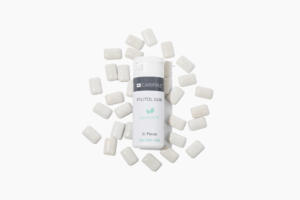Protect Yourself from Tooth Decay: Xylitol
Everything You Wanted to Know about Xylitol
Xylitol has been recognized as an effective anticaries agent and also potentiates the effects of even small amounts of fluoride.1, 2 Xylitol is a much less common anticaries agent than fluoride, and in the United States, and the Food and Drug Administration only recognizes fluorides as “active ingredients” in anticaries products. One of the primary reasons xylitol is often limited to professional dental care and prescription grade products and not included in over-the-counter products is its cost. Xylitol is 5–6 times more expensive per kilogram than most common over-the-counter dental product sweeteners, such as sorbitol. Also, in order to provide an effective “therapeutic dose” of xylitol, a dental care product should have a minimum concentration of at least 10 percent, while other sweeteners are used in much smaller concentrations.3 While xylitol may be listed on many product labels, often patients and professionals must contact manufacturers or search their websites to determine how much xylitol is actually present in the product.
In order to provide an effective “therapeutic dose” of xylitol, a dental care product should have a minimum concentration of at least 10 percent.3
How does xylitol work?
Xylitol is a five-carbon alcohol sugar. It is sweet in taste, similar to sugar (sucrose). Yet it works as an anticaries therapy agent in three ways. First, cariogenic bacteria cannot metabolize xylitol into acid, as they do many other carbohydrates and sweeteners, protecting the teeth from additional acid exposure. Second, because the bacteria cannot metabolize xylitol, it reduces their growth and a bacterial starvation effect occurs that over time can reduce total bacteria levels. Finally, because it is sweet tasting, it causes an increase in salivary flow to aid in the repair of damaged tooth enamel.
Another proven benefit of xylitol is its synergistic therapeutic effect when combined with sodium fluoride. Xylitol can potentiate even very small levels of fluoride. The dental product combination of sodium fluoride and xylitol can provide additional anticaries benefits of 12 percent.3, 4
Xylitol is both noncariogenic in that it does not contribute to cavity formation and cariostatic because it prevents or reduces the incidence of new cavities. Xylitol actually reduces the amount of plaque and the number of bacteria in plaque. No other sugar substitute has been shown to function this way. Xylitol is safe for all age groups, and products specifically designed for children under the age of 2 are available. Xylitol can be found in oral rinses, sprays, toothpastes/gels, wipes, gums, and lollipops for children and adults.
Xylitol and pets
Caution should be exercised with xylitol-containing products around dogs. Although the human metabolism of xylitol does not significantly alter blood sugar, dogs metabolize xylitol differently. In dogs, xylitol ingestion causes a rapid release of insulin and a subsequent rapid drop in blood sugar. If not treated immediately, it could cause liver damage or worse. The toxic dose for a dog is relatively small, so care should be exercised when using xylitol-containing products around dogs.5
The number one source of xylitol ingestion that results in calls to the Pet Poison Helpline, a poison control center for animals, is xylitol gum.6 While it may not be necessary to keep xylitol-containing products in child-resistant containers, it is vital to keep all xylitol-containing products out of the reach of animals.
- H. Maehara, Y. Iwami, H. Mayanagi, and N. Takahashi, “Synergistic Inhibition by Combination of Fluoride and Xylitol on Glycolysis by Mutans Streptococci and Its Biochemical Mechanism, Caries Res 39,no. 6 (2005): 521–528.
- J. F. McClendon, C. W. Foster, Ludwick, and J. C. Criswell “Delay of Dental Caries by Fluorine,” J Dent Res 21, no. 2 (April 1942): 139–143.
- J. L. Sintes, C. Escalante, B. Stewart, et al., “Enhanced Anticaries Efficacy of a 0.243% Sodium Fluoride/10% Xylitol/Silica Dentifrice: 3 Year Clinical Results,” Am J Dent 8, no. 5 (1995): 231–5.
- J. L. Sintes, A. Elias-Boneta, B. Stewart, et al., “Anticaries Efficacy of a Sodium Monofluorophosphate Dentifrice Containing Xylitol in a Dicalcium Phosphate Dihydrate Base: A 30 Month Caries Clinical Study in Costa Rica,” Am J Dent 15, no. 4 (2002): 215–9.
- Pellegrini, N. (2012, July 11). Veterinary Q&A: Why is xylitol so dangerous for dogs and cats? Retrieved from https://www.seattletimes.com/life/pets/veterinary-qa-why-is-xylitol-so-dangerous-for-dogs-and-cats/
- Xylitol and Dogs – Xylitol Toxicity in Dogs – Gum and Dogs. (n.d.). Retrieved from https://www.petpoisonhelpline.com/poison/xylitol/
